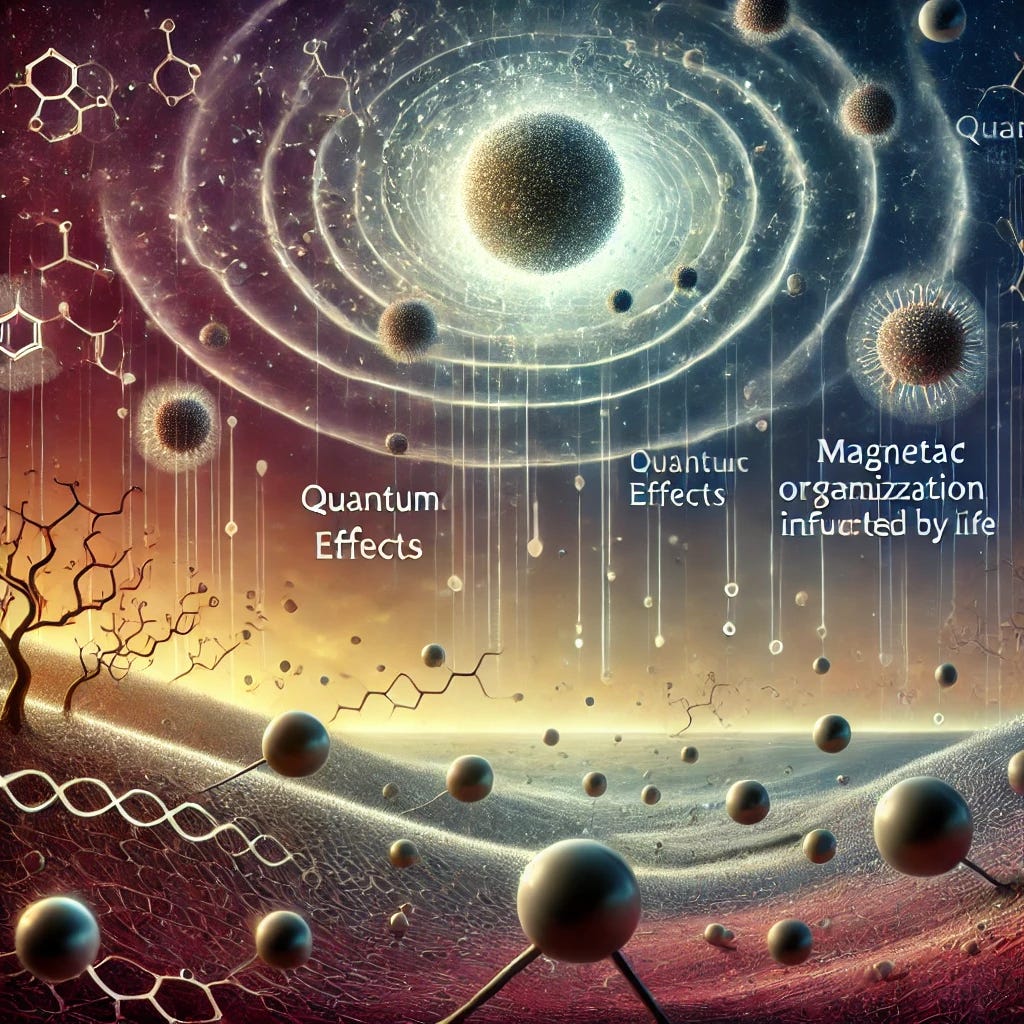The Role of Magnetivity in the Origin of Life
How Magnetic Fields Could Be the Key to Life’s Emergence

Exploring the profound implications of magnetic fields on the formation of life, from molecular organization to the possibility of life beyond Earth.
The potential role of magnetic fields in the origin of life is indeed a compelling area of study. If magnetic fields were instrumental in the formation of the first living cells, it would suggest that life is intertwined with the universe’s fundamental forces in ways we are only beginning to understand. Here’s how Magnetivity could contribute to explaining life’s origins and why this perspective might reshape our understanding of both biology and cosmology.
1. Magnetic Fields as Catalysts for Molecular Organization
Magnetic fields could have provided a stabilizing force in the early Earth environment, encouraging the formation and organization of molecules necessary for life:
Molecular Alignment and Prebiotic Chemistry: Magnetic fields could align or influence polar molecules, encouraging the formation of stable structures. This aligns with prebiotic chemical theories where certain molecules—amino acids or nucleic acids, for example—need stable configurations to link together.
Energy Source and Catalytic Agent: Magnetic fields can affect electron spins, influencing reaction rates. In early Earth conditions, magnetic fields could have served as an energy source, catalyzing key chemical reactions in ways similar to how sunlight or hydrothermal vents are proposed to have done.
2. Magnetic Fields and Chirality
A key aspect of life is chirality, or the “handedness” of molecules. Life on Earth predominantly uses left-handed amino acids and right-handed sugars, but the reason for this preference is still a mystery.
Magnetochiral Effect: Magnetic fields could have played a role in selecting one chirality over another, thus “biasing” the early chemical reactions toward certain structures essential for life.
Symmetry Breaking in Biochemistry: If magnetic fields influenced chiral selection, it would have created a natural pathway toward the uniformity of biochemical structures, paving the way for more complex, self-replicating molecules.
3. Magnetic Fields and Quantum Effects in Biochemistry
The influence of magnetic fields on quantum processes could have created favorable conditions for life’s building blocks.
Quantum Coherence in Biological Molecules: Some researchers propose that coherence—a quantum effect where particles maintain connected states—could be stabilized by magnetic fields. In an early, chaotic environment, such coherence might have enabled reactions to occur in sync, creating more complex molecules and giving rise to primitive life forms.
Quantum Tunneling in Prebiotic Chemistry: Magnetic fields may have affected electron tunneling in early molecular systems, helping molecules overcome energy barriers that would have otherwise prevented key reactions. This could have enabled complex molecules to form more readily in prebiotic soup, setting the stage for the formation of proto-cells.
4. Magnetic Fields and Proto-Cellular Membranes
Magnetic fields might have influenced the formation of proto-cellular structures or even stabilized the first biological membranes.
Micelle Formation and Stabilization: Fatty acids and other amphiphilic molecules (those with both hydrophobic and hydrophilic properties) can form into spherical micelles, a precursor to cell membranes. Magnetic fields might have influenced the shape, stability, and even permeability of these micelles, encouraging them to form robust enclosures that could support biochemical reactions.
Interaction with Minerals and Iron: Magnetic materials, especially iron, could have facilitated proto-cellular formation. Minerals with magnetic properties may have anchored organic molecules, creating localized environments for the concentration and protection of prebiotic chemicals.
5. Implications for Extraterrestrial Life
If magnetic fields are fundamental to life’s origins, then life elsewhere in the universe might also depend on such fields, guiding our search for extraterrestrial life.
Search for Planets with Magnetic Fields: Magnetic fields might indicate planets with stable environments capable of supporting life. The presence of a magnetic field could be a clue to astrobiologists when prioritizing exoplanets for study.
Universal Conditions for Life: A Magnetivity-based origin of life would suggest that life could arise in diverse environments as long as magnetic fields are present. This expands the potential habitable zones beyond Earth-like planets to environments where magnetic and chemical conditions align to foster life.
6. Philosophical and Cosmological Implications
If magnetic fields were central to life’s emergence, this perspective would challenge traditional views that regard life as an anomaly in an otherwise indifferent universe.
Interconnectedness of Life and Physical Laws: This idea places life as an extension of the fundamental forces, suggesting that the laws governing the universe may inherently encourage life.
A Universe Primed for Life: Magnetivity suggests that life is not a chance occurrence but could be an expression of the universe’s underlying properties, as if the universe itself were “primed” for life. This would elevate magnetic fields to a position of central importance in cosmology, with implications for understanding the very nature of reality.
Conclusion
The potential role of magnetic fields in the origin of life could redefine our understanding of life’s place in the cosmos. By exploring Magnetivity’s influence on molecular organization, quantum behavior, chirality, and proto-cellular structures, we gain insight into how magnetic fields might not only have sparked life on Earth but could also be a universal requirement for life’s emergence. This perspective encourages a profound reconsideration of life as an integral part of the universe’s fabric, bound not just by biology but by the very forces that govern existence.

